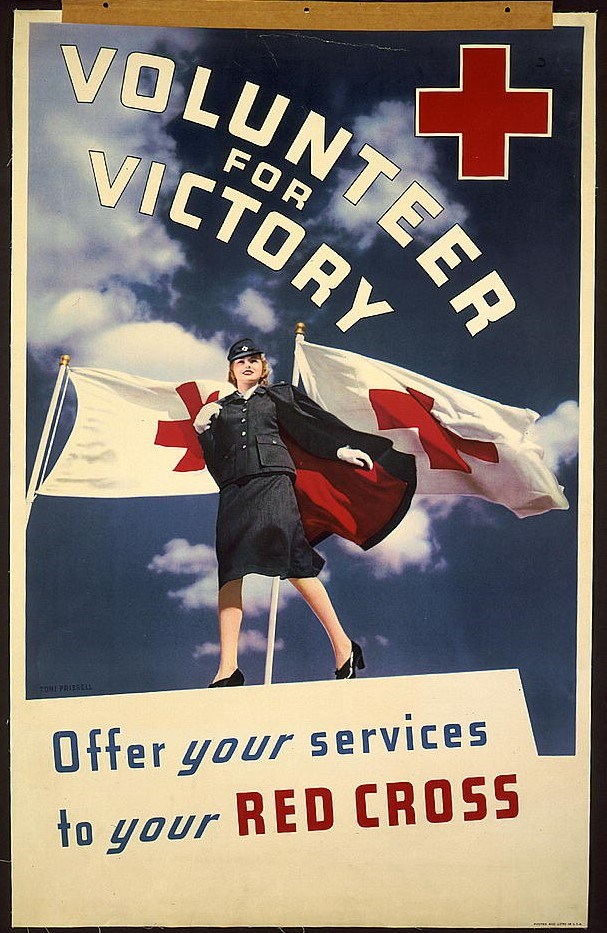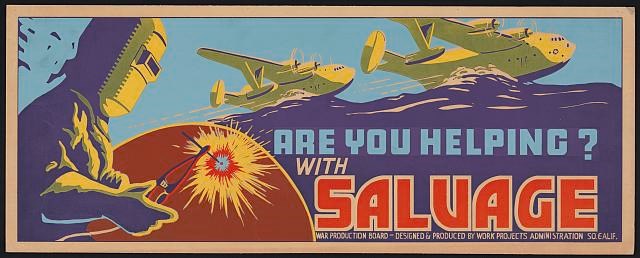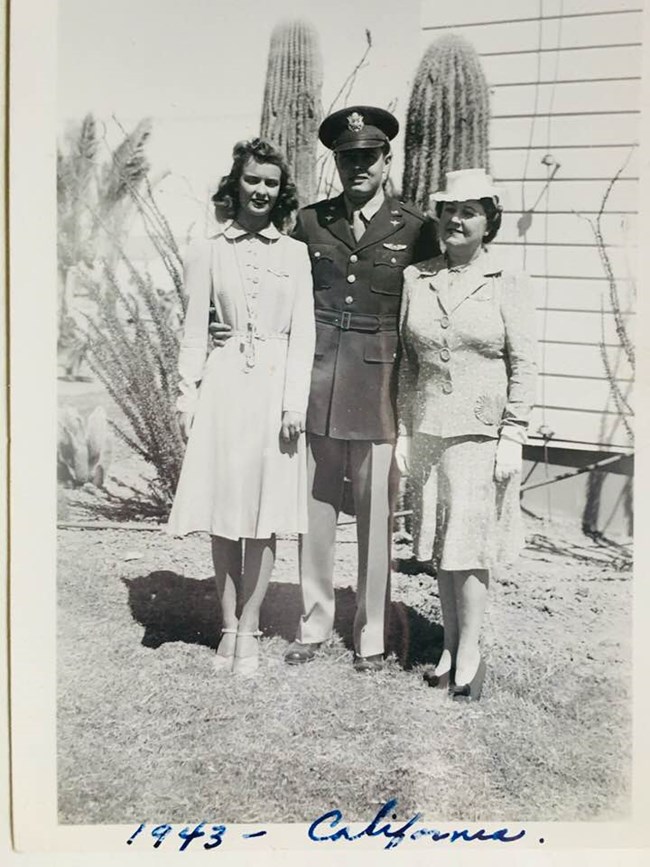Part of a series of articles titled Lewistown, Montana, WWII Heritage City Lessons.
Article
(H)our History Lesson: Civilian Volunteerism and Contributions on the Home Front in Lewistown, Montana, World War II Heritage City

Library of Congress
About this Lesson
This lesson is part of a series teaching about the World War II home front, with Lewistown, Montana designated as an American World War II Heritage City. The lesson contains readings and photos to contribute to learners’ understandings about the ways civilians contributed to home front efforts. These efforts included Red Cross volunteers, participating in scrap and salvage drives, air raid wardens, and victory gardens.
Objectives:
- Identify examples of ways civilians volunteered on the home front in Lewistown, Montana.
- Describe how volunteer efforts in Lewistown contributed to the war efforts.
- Compare local, historical perspectives on service to synthesize and connect to larger wartime perspectives and themes.
Materials for Students:
- Photos (can be displayed digitally)
- Readings 1, 2, 3 (and optional extension)
- Recommended: Map of Montana with Lewistown marked; other airfields can also be marked.
Getting Started: Essential Question
How did civilians in Lewistown, Montana contribute to home front war efforts, and why were their contributions significant?

Credit: Library of Congress
By the numbers:
- 5, 874: Approximate population of Lewistown, Montana in 1940; 6,573 in 1950 (US Census)
- Fergus County six months scrap quota: 1,637,000 lbs (Lewistown Democrat-News, February 2, 1943, p.8)
- 100 local citizens had completed a voluntary air raid warden course by September 22, 1942 (Lewistown Democrat-News, p.3)
Quotations to consider:
“With American service men stationed in every part of the world, the burden of the American Red Cross is far heavier than anything ever before experienced. Realizing this, we believe the contributions from Lewistown people will be prompt and generous.” -City Air Raid Wardens will Open Red Cross 1943 War Fund Throughout City Today, January 16, 2024, p.2
Read to Connect
Background: Mrs. Alfred Walter (A.W.) Johnson, chairman of the Fergus County Red Cross Surgical Dressing committee in the article, was the mother to Second Lieutenant Stanley W. Johnson. Second Lieutenant Johnson went missing in action over the Pacific on November 7, 1943. The minuteman electronics building on Malmstrom Air Force Base was renamed Johnson Hall in his honor in 1963. Mrs. A.W. Johnson, Gold Star mother, was the paternal grandmother of Robin Fleming of Lewistown, Montana. Fleming contributed scanned copies of the following article, and the photo.
“250 Fergus County Women Making Red Cross Surgical Dressings”
Fergus County Argus, December 24, 1942, p. 1-2. (Lewistown is located within Fergus County.)
That the women of Fergus County are wholeheartedly contributing to the nation’s war effort is evidenced in the report today by Mrs. A.W. Johnson, chairman of the Fergus County Red Cross Surgical Dressing committee.
The task of folding dressings, Mrs. Johnson states, is indeed a tedious one and the nearly 175 workers in Lewistown are doing an excellent job. Perfection and not speed is the aim at all the classes which are held daily, above the P.C.A. offices, except Saturday and Sunday, from 9 a.m. to 5:30 p.m. and each Monday evening from 7 p.m. to 11 p.m.
After the holidays two and perhaps three evening classes will be in session during the week. When it is realized by the ladies that every dressing folded will be used for the boys of the United States forces only, the pains taken to turn out a 100% dressing is clearly evidenced. Two types of sponges are being made by the Fergus County women, both of which dressings are applied directly to the wound so the importance of keeping them sterile is plain to see. Each worker, before entering the surgical dressing room, must change from her street clothes to a fresh cotton dress, preferably white, must wear a head covering and have her fingernails free from any artificial polish. The quota assigned to any one chapter is classed a military secret and must not be divulged, Mrs. Johnson informed the Argus today.
In addition to the Lewistown ladies folding dressings, a work room has been established at Denton where regularly 60 ladies of that community devote a certain number of hours to the project. Mrs. Johnson reported that the Denton group, working under the Fergus County chapter, had obtained an excellent work room and the job they were doing was greatly augmenting the work in this city. Their number brings the total number of women folding dressings to nearly 250.
The surgical dressing program is the largest, single Red Cross endeavor that has ever been undertaken and the women of the United States, volunteering for duty, will turn out 90% of the dressings which are to be used.
A number of important revisions as a result of the experience gained in making the first reserve stock of 40 million dressings for the U.S. army have been forthcoming. Surgical dressings for the army must conform to the specifications given in the Red Cross manual. When a large number of individuals are working on a project, uniformity in all processes and in the finished product is essential. The highest standard of workmanship must be maintained. If a chapter is unable to provide proper supervision to fulfill these requirements, it should not accept a quota as the errors and poorly made dressings of one chapter offset the splendid work of many. The manual also stresses that absolutely no deviations in the directions for the dressings are allowed. Specifications are made up under the orders of U.S. Army surgeon General. . .”
City’s Scrap Metal Drive Swings Into High Gear Thursday; Speeds Up Today
Lewistown Democrat-News, October 2, 1942, p. 3
More Valued Keepsakes Added to Growing Stack of Scrap Metal Vital to War Effort as County Salvage Depot Trucks Kept Busy Picking Up House to House Contribution
A Japanese Prayer Mirror and a 27-85 M.M. shell of World War I days were added to the tons of scrap metal which started rolling in from practically every household and business house Thursday as Lewistown’s part in the Fergus County intensified scrap metal drive, sponsored by the newspapers of America, was shifted into high gear preparatory to an accelerating climax today and grand finale Saturday.
The three big trucks from the county salvage depot, corner Fourth and Erie were kept rolling from early morning until late at night, with the truckers endeavoring to reach at least a majority of the homes and business houses where a pickup was requested for Thursday. There were stacks of metal scrap in front of practically every home Thursday morning, while in the business district the scrap piles appeared in the interior of many stores as well as at the alley entrances.
The truckers will still be on the move today and any ‘Thursday’ customer who was overlooked will be cared for, if possible, before the week ends. However, just in case of an oversight, anyone who was overlooked and wants to be sure that his or her metal scrap contribution to the war effort is called for, is asked to call Phone 1250 at the County Salvage depot.
The decidedly rare ‘Japanese Prayer Mirror’ turned in to Scrap Chairman Harold Erickson was contributed by Mrs. John M. Heckler, while Dr. Kidder donated the World War shell keepsake.
Everyone is urged to keep hunting for metal scrap, as the campaign does not end until October 17, and every ounce is vitally needed to keep the war making machinery of the nation moving.
Mounted Air Raid Warden Detachment Being Formed Here
Lewistown Evening Telegram, May 6, 1942, p.4
What is believed to be the first Mounted Air Raid Warden detachment under the Fergus County civilian defense setup in Montana is now assured for Lewistown, it was announced Tuesday at local civilian defense headquarters. This innovation and civilian defense preparedness has come about through the personal efforts of Cy Price and Charles Cooley, both of whom are ardent horsemen. They in turn have enlisted the volunteer services of other local horsemen and making up a mounted air raid warden unit of what eventually will be 15 or 20 members. Many of whom have already signed up at local civilian defense headquarters for this work.
At a later date, this group expects to set up their own staff, which will work in conjunction with the regular defense air raid wardens under the general chairmanship of Sheriff Tullock and his Assistant Chief of Police, A.C. McKnight. Among those already signed up for Fergus County's Cavalry Civilian Defense Detachment, in addition to Messrs. Price and Cooley, are T.R. Biggerstaff, Ken Mortag, Evan Hall, Bill Goodrich, Clifford Pallett, R. R. Williamson and Dr. C. P. Smith.

Photo credit: Robin Fleming, granddaughter of A.W. Johnson
Student Activities
Questions for Reading 1 and Images
- In the reading, how do the women of Fergus County contribute to the nation's war effort?
- What measures did the volunteers take to ensure the quality of their work?
- How did the surgical dressing program connect to broader wartime initiatives? Consider the involvement of women volunteers.
Questions for Reading 2
- Why were there scrap metal and material drives on the home front during the war?
- What unique items were added to the scrap metal collection in Lewistown as part of the Fergus County scrap metal drive? Why do you think these items were highlighted?
- Based on the details in the reading, how effective was the scrap metal drive with community participation and raising awareness of the importance of contributing to the war effort?
Questions for Reading 3
- What made civilian defense preparedness and volunteer contributions important on the home front?
- How would the mounted air raid warden unit contribute to civilian defense preparedness in Lewistown?
- Why was it important to use horsemen for air raid defense in a rural place like Fergus County, considering things like the land and what resources are available?
- How did civilians in Lewistown, Montana contribute to home front war efforts, and why were their contributions significant?
Lesson Closing:
Using details from across the readings, describe some of the different ways civilians contributed to the home front efforts in Lewistown.
- How did civilians in Lewistown, Montana contribute to home front war efforts, and why were their contributions significant?
Extension Reading
Victory gardens were another way that civilians in Lewistown contributed to the home front. To increase motivation and excitement around gardening, a local newspaper hosted a Victory Garden competition with prizes.
Democrat –News will Sponsor Victory-Garden Event, in Line with Food-For-Victory Drive
The Judith Basin Farmer (Lewistown, Montana), March 4, 1943, p.2
With a view to lending encouragement to the nationwide Victory Garden campaign and furnish added incentive for every resident to put in a private garden as a means of supplementing the family larder pinched by necessary rationing of foods needed for the boys overseas, the Democrat-News in cooperation with other local concerns and individuals has arranged to make special interest arousing prize offers.
As part of the plan the Democrat-News will give out $25 in war stamps for the best gardens and during the growing and harvesting season will devote its display window to out-of-the-ordinary and peculiar garden grown vegetables, fruits, plants and such like, brought to the office.
Other special prizes to be announced later will be offered by merchants, seed houses and other concerns and individuals, with a view to making the prize distribution as widespread as possible.
Small gardens as well as large ones will have an equal chance in this interesting war-aid contest, with neatness, variety, size, and growth of plant products all to be given consideration in the final judging. . . .
This lesson was written by Sarah Nestor Lane, an educator and consultant with the Cultural Resources Office of Interpretation and Education, funded by the National Council on Public History's cooperative agreement with the National Park Service.
Tags
- american world war ii heritage city program
- world war ii
- wwii
- world war 2
- ww2
- world war ii home front
- wwii home front
- awwiihc
- women in world war ii
- american red cross
- world war ii mobilization
- civiian volunteers
- volunteerism
- victory gardens
- civilian defense
- hour history lessons
- teaching with historic places
- twhp
- twhplp
Last updated: September 18, 2024
